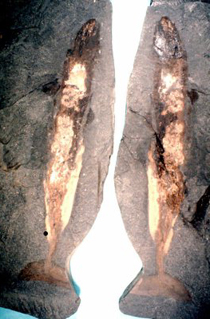Most of the vertebrate remains that have been found in the late Pennsylvanian and early Permian strata of southeastern Nebraska are elasmobranchs, a group of fishes that includes sharks, rays, chimaeroids, sawfish, and guitar fish. These fishes have wholly cartilaginous skeletons. Their placoid scales and teeth are similar to the teeth of higher vertebrates, having a layer of enamel covering a layer of dentine that encloses a pulp cavity. The most primitive elasmobrahchs have seven gill slits and more advanced forms have five. Elasmobranchs of the late Paleozoic seas filled several ecological niches and include forms that were carnivores with flesh cutting teeth, carnivores with teeth modified to crush shells, and teeth that may have functioned as filters to extract plankton including algae and small animals from the sea water. One form of tooth found in the Kiewitz Shale may have functioned much like the "beak" on the modern parrot fish that feeds on corals.
The late Pennsylvanian and early Permian rocks of southeastern Nebraska and the adjoining areas have produced some outstanding examples of fish fossils from black, offshore shale horizons that represent the deepest water during marine transgressions that have periodically covered the North American Midcontinent. These sedimentary deposits are called cyclothems and they include both continental and marine sequences. A typical cyclothem in the model put forth by Heckel and Baesemann (1975) and Heckel (1977) begins with a nearshore shale that is of continental origin. The continental deposits are followed by tidal, mud flat, and lagoon or estuary deposits that may contain sandstone beds laid down by ancient streams. The upper part of the near shore shale may contain marine invertebrate fossils such as brachiopods, mollusks, and occasional fish teeth or spines. These deposits are followed by the deposition of a fairly thin, dense, finely crystalline limestone that is called the transgressive limestone. The transgressive limestone may contain an abundant and diverse fauna but most of it has to be identified by studying thin sections or polished sections of the rock because the fossils are extremely difficult to be removed from the dense, hard matrix. At the top of the transgressive limestone, one can commonly observe almost intact fossil communities with many different kinds of marine invertebrate and vertebrate fossils. The offshore shale has a non-black portion in its lower reaches and here the fossil abundance and diversity is probably the greatest of all that are found in the cyclothem. This is because there are numerous niches to be filled, the water is sufficiently shallow to allow algae growth and carbonate production, and establishment of a long food chain. Most of the fossils from this part of the cyclothem are small, inornate forms, suggesting deeper, cooler water. The phosphate rich, black facies of the offshore shale represents cold, deep, dyaserobic (oxygen deficient) to anoxic (no oxygen) water. The depth of the water was below the photic zone (maximum penetration of sun light) and no algae was produced on the sea floor. Decaying algae and other organic matter provided both phosphate and carbon that resulted in the black shale that has a foetid odor. This environment provided an opportunity for many unusual fossils to become preserved as imprints and skeletons as they settled to the bottom of the sea. The black facies of the offshore shale is commonly succeeded by deposition of shale that is nearly a mirror image of the non-black portion of the offshore shale. These beds are followed by deposition of usually thick, coarsely crystalline regressive limestone that contains large, often highly ornamented fossils that suggest they lived in warm, shallow, well-oxygenated water. The regressive limestone may contain shoal deposits near its top and it may be weathered and show evidence of soil development. A new cyclothem begins at this time and the cycles have repeated themselves many times during the late Paleozoic in the midcontinent.
Pennsylvanian and Permian age fish remains found in Nebraska have been the subject of various researchers since about 1850. Joseph Leidy (1854); J. S. Newberry and A. H. Worthen (1866, 1870) described several species of teeth from shark-like fishes from the Coal Measures of Nebraska. O.W. St. John and A. H. Worthen(1875, 1883) completed two important studies on these fossils. Near the turn of the century, E. D. Cope (1871, 1875, 1877, 1883, 1889, 1891, 1894) described many late Paleozoic vertebrate fossils from the North American Midcontinent, including much Nebraska material. C. R. Eastman (1896, 1897, 1899, 1900, 1901, 1902a, 1902b, 1902c, 1902d, 1902e, 1903a, 1903b, 1904, and 1917) recorded many fossil fishes from the midcontinent. Eastman with and E. H. Barbour (1902) summarized the fish fauna from the late Paleozoic of Kansas and Nebraska. Research remained static until 1934 when A. S. Romer and H. J. Smith published the results of studies of Carboniferous dipnoans (lungfish). In more recent times, M. C. Hansen (1968), L. D. Martin (l969, 1972, C. R. Ossian (1974), and R. Zangerl and G. R. Case (1973), and J. Maisey (1981) have actively studied Pennsylvanian and Permian age fishes. Erom the late 1960's and early 1970's, W. D. White, William J. Rushlau, and Gerard R Case collected many of the fish fossils from the black shale facies in the midcontinent. Some of these finds are shown here. This page also illustrates some of the fish, teeth, fins, and other remains they have collected.
